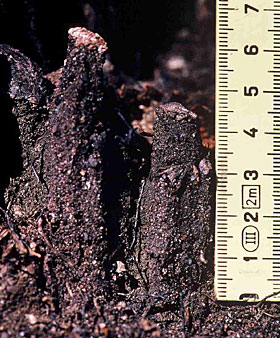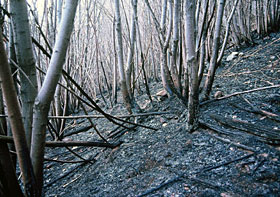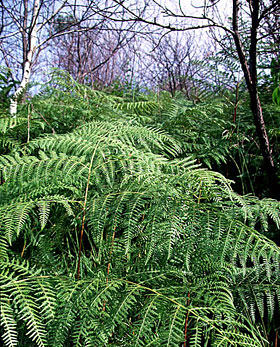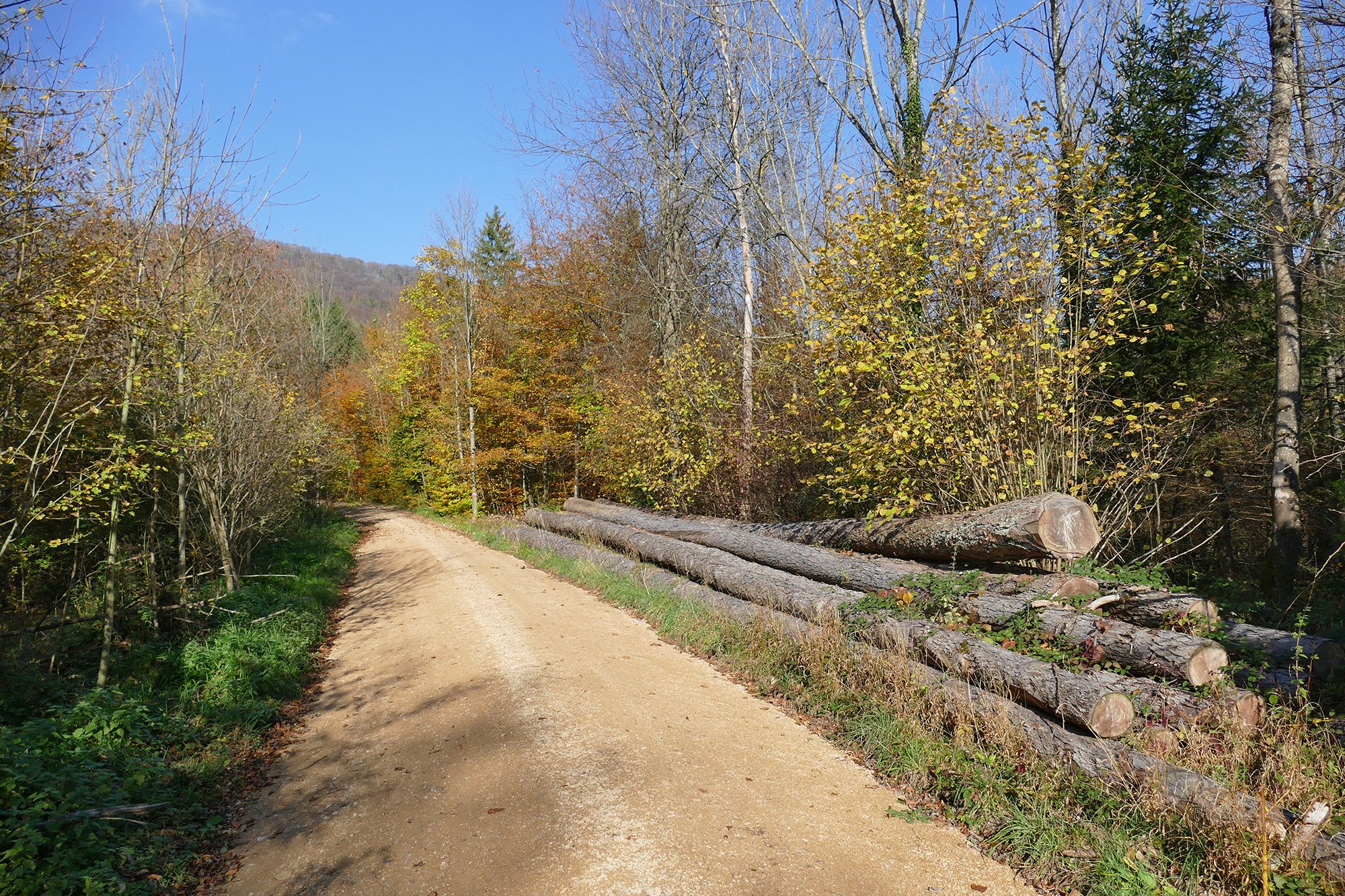The fire regime

Fig. 1 Typical erosion caused by rain drops after a forest fire. Photo: Peter Marxer (WSL Bellinzona)
Fire is an irregular and heterogeneous phenomenon. Forest fires can be classed according to their typology.
- Ground fires (smouldering fire, which slowly burns underground material).
- Running fires (quick advancing surface fires, which only burn material on the surface).
- Crown fires (fierce flames, which extend up to the tree crowns).
- A combination of these types.
Depending on prevailing weather conditions and the fuel characteristics forest fires can vary in intensity, seasonality and frequency. The combination of these elements is called the "fire regime".
In cases of high fire disturbance (frequent and intensive fires) only fire adapted plant species usually survive. Species which recover and regenerate slowly and with difficulty after a fire are in danger of being wiped out by frequent occurrences. In evaluating post-fire effects it is therefore important to consider not only the last event, but the whole former fire history, that is to say, the fire regime of the area. This is also true for the post-fire erosion and run off.
Consequences of a forest fire on the soil
The fire burns the litter layer and part of the humus layer. Therefore stones on the surface become destabilized. In mountain areas it is often the case that a stone starts rolling during a fire. The worst consequences of a fire however occur after the fire: the lack of cover from ground and tree vegetation allows rain drops to hit the soil directly. Due to this soil structures are destroyed and erosion and washing out take place (Fig. 1). The bare soil dries out quicker and its surface becomes impermeable. The rain tends to flow off the surface eroding rills and gullies into the soil. (Marxer 2003).
On what do erosion and run-off depend?

Fig. 2 Build up of ash after a fire. A rule of thumb says: the whiter the ash after a forest fire, the more intense the flame front.
Photo: WSL Bellinzona

Fig. 3. In repeated burn area, the bracken grows thick and lush.
Photo: Peter Marxer (WSL Bellinzona)
The impermiability of the soil depends on the temperature of the fire (higher temperatures mean greater destruction of the soil structure) and from the production of ash (greater quantities of fire material and more intensive fire produce more ash (Fig. 2)), which then physically blocks the soil pores (Letey 2001). These negative effects mainly happen in the first months after the fire. In areas which have not been recently affected by forest fires or other disturbances, or which have a lack of light-demanding and quick reacting plant species adapted to disturbances, there is a longer period of danger from erosion (Fig 3).
The occurrence of all these negative factors simultaneously can lead to catastrophic consequences. This was the case in the spring of 1997 when a long dry period and strong Föhn winds led to widespread and devastating forest fires in Tessin and in Misox. Precipitation following the fire led to larger and smaller mudslides at the following places:
- Mezzovico (as a result of the forest fire of 4th April 1997)
- Rosone (Valcolla, as a result of the forest fire of 3rd April 1997)
- Grono (as a result of the forest fire of 16th April 1997)
- Roncos (Ascona 4000m³ mud slide as a result of the forest fire of 15th March 1997)
- Magadino (as a result of the forest fire in the Valley del Trodo on 20th April 1997)
How can erosion be reduced?
Unfortunately there are no technical or silvicultural measures known which could be put into place to make a forest fire area safe from erosion in an acceptable time and with a reasonable amount of effort. It is however possible to calculate the intensity of rain which could lead to damage in a given forest fire area. Thus when large amounts of rainfall are predicted necessary alarm and safety precautions could be taken (e.g. the closing of endangered roads).
References
- Marxer, P., 2003. Oberflächenabfluss und Bodenerosion auf Brandflächen des Kastanienwaldgürtels der Südschweiz mit einer Anleitung zur Bewertung der post-fire Erosionsanfälligkeit (BA EroKaBr). Physiogeographica 33: 217 S.
- Letey, J., 2001. Causes and consequences of fire-induced soil water repellency. Hydrol. Process., 15, 2867-2875.
Translation: Dawn Meister, Stallikon


![[Translate to English:] [Translate to English:]](/assets/_processed_/f/2/csm_fva_waldbrand_wb1_abb3_eb44a09bed.jpeg)
![[Translate to English:] [Translate to English:]](/assets/_processed_/3/2/csm_fva_waldbrand_wb2_823e18b47f.gif)
![[Translate to English:] [Translate to English:]](/assets/_processed_/0/b/csm_kontrolliertes_brennen_132efdbfa3.jpeg)